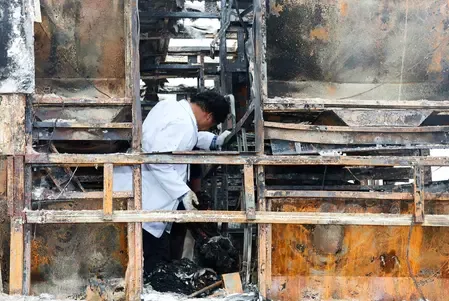Are 80,000 Children in West and Central Africa at Risk of Cholera?

Synopsis
Key Takeaways
- The UN estimates 80,000 children are at risk of cholera in West and Central Africa.
- Active outbreaks in DRC and Nigeria threaten neighboring countries.
- UNICEF requires $20 million for emergency response efforts.
- Cholera is linked to lack of safe water and sanitation.
- Swift treatment is essential to save lives.
According to the United Nations on July 31 (NationPress), approximately 80,000 children face a heightened risk of cholera as the rainy season approaches in West and Central Africa. A representative from the UN indicated that active outbreaks in the Democratic Republic of the Congo and Nigeria pose a significant threat of cross-border transmission to nearby nations.
Countries including Chad, Republic of Congo, Ghana, Cote d'Ivoire, and Togo are currently struggling with ongoing epidemics, as reported by UNICEF. Meanwhile, Niger, Liberia, Benin, Central African Republic, and Cameroon are under surveillance due to their vulnerability.
Since the onset of these outbreaks, UNICEF has been actively supplying health, water, hygiene, and sanitation resources to treatment centers and communities.
In addition to cholera vaccination efforts in affected regions, families are being encouraged to seek treatment and enhance hygiene practices. There is an urgent need for scaled-up initiatives to curb the spread of the disease across the region, as reported by the Xinhua news agency.
To strengthen the emergency response over the coming three months, UNICEF West and Central Africa urgently seeks $20 million to support health services, water and sanitation, risk communication, and community engagement.
The World Health Organization states that cholera is an acute diarrheal disease caused by consuming food or water contaminated with the bacterium Vibrio cholerae. This condition represents a global public health risk and highlights social and economic disparities. Access to safe water, basic sanitation, and hygiene is crucial in preventing cholera and other waterborne illnesses.
While many cholera patients experience mild or moderate diarrhea that can be treated with oral rehydration solutions (ORS), the disease can escalate rapidly, making swift treatment essential for survival. Severe cases require intravenous fluids, ORS, and antibiotics.
Robust epidemiological and laboratory surveillance is crucial for promptly identifying and monitoring outbreaks and guiding effective responses.
Cholera outbreaks are common in certain countries, while in others, they are infrequent, sometimes occurring years apart. Cholera is often associated with limited access to safe water, basic sanitation, and poor hygiene practices, which can stem from conflict, population displacement, climate events like cyclones, floods, or droughts, and insufficient investment in improving WASH services and infrastructure.
Reported cholera cases to the WHO have been increasing in recent years. In 2023, a total of 535,321 cases and 4,007 deaths were reported from 45 countries. The difference between these figures and estimates from researchers is likely due to inadequate surveillance systems and unreported cases due to fears of repercussions for trade and tourism.









